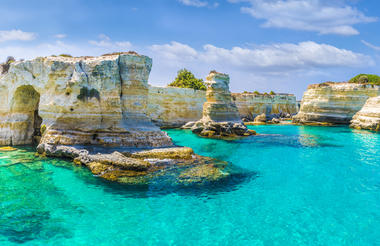Presided over by mighty Mount Vesuvius, with the remarkable archaeological site of Pompeii on its doorstep, the historical Mediterranean city of Naples has a long and fascinating history. Naples predates the Italian state and the Roman Republic by centuries, resulting in a virtually unrivalled bounty of Greek and Roman artefacts. Naples is unlike any other Italian city - it is huge, edgy, and disorderly, and yet this contemporary mayhem carries on against a backdrop of some of Italy’s grandest and most impressive historical squares, world-class museums, and breathtaking Baroque masterpieces. As the birthplace of pizza and home to arguably the most sumptuous culinary scene in a country famous for its excellent food, Naples boasts numerous gastronomic establishments to thrill food lovers with all manner of tasty delights.



Procida is an island in the Bay of Naples, situated off the west coast of Italy. This small island – accessible by ferry from Naples (about five kilometres away) – features a number of historic sights, outdoor attractions, as well as excellent restaurant and accommodation options. History buffs will enjoy exploring Terra Murata (the medieval Old Town) and the ancient fishing area of Marina di Corricella, which offers a range of restaurants set amongst brightly-coloured houses. Vivara, a nature preserve, is a small islet attached to Procida via a bridge and is a must for nature lovers (as well as a popular location for movies, such as The Talented Mr. Ripley), while the rocky cliffs and beaches offer active travellers a variety of walking and water sport options.
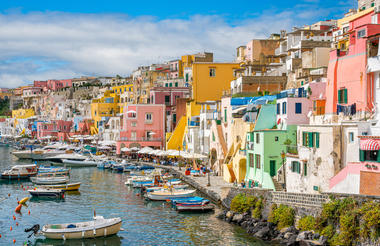


Rising out of the Mediterranean, the volcanic outcrop of Ischia is situated in the Gulf of Naples, stretching for ten kilometres east to west and seven kilometres north to south - it is considered the most beautiful of the Italian islands. It is best known for its fishing heritage, mineral-rich hot springs, magnificent turquoise waters fringing idyllic beaches, and picturesque villages which offer a variety of restaurants, cafes, and bars. Visitors can explore the medieval Aragonese Castle, connected to Ischia by an ancient stone walkway; view the Church of the Madonna del Soccorso, which has an impressive blend of Moorish and Byzantine architecture; and bathe in the beautiful Sorgeto hot springs, a variety of natural pools of different temperatures right on the seashore.
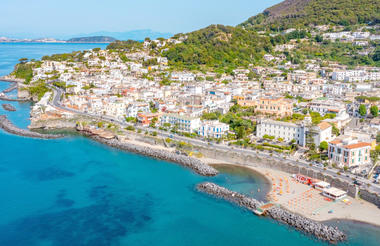
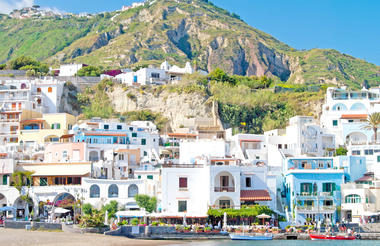
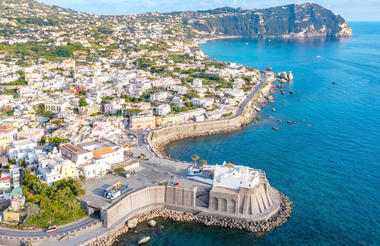
The small but spectacular island of Capri is located off the western coast of Italy in the Bay of Naples. A celebrated tourist destination, Capri is a beautiful place to visit, with elegant buildings, dramatic cliffs and some unbelievable natural attractions. Accessible via a charming rowboat, the Blue Grotto (Grotta Azzurra) is a cave at the entrance to the sea where visitors can admire the waters, lit from beneath by the sunlight and shimmer in incredible hues of blue. For architecture fans, the ruins of the 2,000-year-old palace of Villa Jovis are fascinating to explore, while Villa Lysis is an Art Nouveau masterpiece and Villa San Michele boasts tranquil and expansive gardens. Capri’s selection of popular upmarket restaurants provides mouth-watering local fare - make sure to try the seafood pasta dishes.



The otherworldly beauty of the Amalfi Coast stretches for 48 kilometres on a magnificent mountain coastline in the southwestern Italian region of Campania. It is known for its historic ruins, breathtaking natural views, and, of course, its iconic pastel-coloured, medieval fishing villages, which cling to the side of steep cliff faces towering above the glistening Mediterranean Sea. The vertical landscape of Amalfi features a continuous succession of bays, fjords and public gardens, interspersed with lovely little pebbled beaches. For decades this UNESCO World Heritage Site has been one of Italy's major tourist attractions, offering visitors excellent restaurants, hotels, bars, boutiques, and boat trips. The area is also famous for its sweet and zesty limoncello liqueur (owing to its abundance of lemons) and its colourful, exquisitely-decorated handmade ceramics.



Carved out of rocky mountain slopes in the Basilicata of southern Italy, the ancient town of Matera is a tightly knit cluster of layered stone dwellings twined together by a labyrinth of steep winding staircases and flat dual-purpose rooftops that act as the streets of the level above. The houses, known as the Sassi di Matera, invoke images from the nativity, an impression well-utilised by famous filmed director Mel Gibson as a substitute for Bethlehem in the film 'The Passion of the Christ'. As one of the oldest cities in the world, it boasts a wealth of historic landmarks, such as the Civita district, a natural fortress home to a Romanesque Cathedral, which houses many works of art, including a 13th-century statue called Madonna della Bruna. The Park of the Rupestrian Churches spans over 8 000 hectares and counts over 150 churches, including the impressive Santa Maria de Idris.



Salento, the ‘heel’ of Italy’s ‘boot’, is a romantic region in Apulia, southern Italy. The area includes Lecce, a gorgeous destination featuring a vibrant city filled with a rich heritage. It is often referred to as the ‘Florence of the South’ for its numerous Baroque buildings, and producing unique paper-mache sculptures. The ‘Pearl of Salento’, Castro Marina, buzzes with nightlife, excellent restaurants and stunning ocean vistas, and offers fantastic boating, canoeing and cave-exploring experiences. The coastline of Salento is diverse and breathtaking, moving from rugged promontories to idyllic little coves ringed with perfect sandy beaches, easing into crystalline waters. Other highlights include thermal springs, world-famous olive oil, and Otranto’s magnificent cathedral floor mosaic, the largest in Europe. The spectacular craftsmanship of local stonemasons through the centuries can also be seen all over the area.


